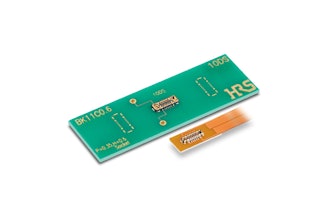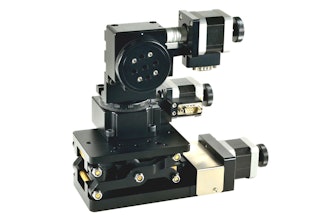
Some of the best solutions are born out of necessity. Bob Provencher, Director of Technology and Sales at SafeConnect Systems would agree. In 2011, the company was approached by a grocery retail chain seeking a safe electrical solution to power its new Hybrid Electric Transport Refrigeration Units (eTRUs) to use with its fleet of refrigerated semi-trailers. (Note: Unlike traditional diesel-powered transport refrigeration units [TRUs], eTRUs are hybrid diesel-electrics, capable of plugging into the electric grid when parked.)
Initially, the grocery retailer had wired its facility with traditional 4-pin high voltage connection equipment to run the eTRUs on electric standby power. However during a final review of the project, the company’s Environmental, Health & Safety (EHS) staff recognized potential safety vulnerabilities with the design of the legacy equipment chosen to connect the reefers (refrigerated trucks) to the electric grid. EHS determined that the company needed a system that would eliminate the potential for human error in making volumes of high voltage connections and disconnections by many different operators with varying skill levels. They quickly realized they needed a safer system.
Provencher explained, “At the time the customer reached out to us, there was nothing available on the market to meet their requirements. We contacted various manufacturers of hybrid eTRUs and they were unable to offer any other type of electric standby connector aside from the traditional 4-conductor twist-lock designs. This need ignited a product development effort to find something different, something better, something safer.” After about two years of research and development, the SafeConnect Electric Standby Connection System was launched. The new e-Standby system was designed specifically for use with eTRUs on both refrigerated trucks and trailers.
Electrical Safety is Key
What makes SafeConnect a true leader in the electric standby market is the company’s commitment to safety. While other electric standby systems use standard pin and sleeve or bladed twist-lock devices (4-pins), SafeConnect uses a proprietary 6-pin connection system, incorporating auxiliary contacts and a tension release feature, provided by the MELTRIC Corporation.

The SafeConnect system can only be energized by first joining the plug and receptacle together and then pushing the “ON” button. Connecting the docking station’s 6-pin, spring-loaded receptacle to the 6-pin truck/trailer-side plug closes the control circuit and only then is high voltage power allowed to flow through the system.
In the event of an operator error, such as a driver neglecting to press the “OFF” button before disconnecting, no harm will occur to the operator, the plug, or the receptacle. Any disconnection, even while under load, will completely de-energize the entire system before a dangerous electrical arc can develop.
The configuration of the 6-pin SafeConnect System, which uses varying pin heights to make and break electrical connections, mitigates the inherent risk of exposure to high voltage electricity. This reduces the risk of accidental electrical shock. Unlike previous legacy equipment, SafeConnect’s unattended cable and receptacle cannot be in an energized state without being connected.

Arc-Proof Technology with SafeConnect
Electrical arcs can occur with legacy equipment when an electrical connection or disconnection is made without complete system de-energization. These arcs are extremely dangerous and can result in serious injuries, including electric shock and burns. Additionally, arcs can scar plugs and receptacles, which creates added electrical resistance that in turn leads to a voltage drop in the power distributed to the refrigeration unit. An eTRU motor then compensates for the voltage drop by drawing more amperage, which can result in equipment damage or malfunction.
Accidental Drive-Offs
Accidental drive-offs are a big safety issue with 4-pin twist-lock connectors. Should a driver forget to unplug, serious damage can result to the trailer and docking station as the power cord gets ripped off by the vehicle pulling away. Worse yet, drive-offs can result in human exposure to live, dangerous, high voltage wires lying on the ground.
SafeConnect eliminates this dangerous scenario by using a spring-loaded, tension-activated plug/cable release. As soon as the system senses movement in the connecting cable, the receptacle and power cable automatically eject from the trailer’s plug. When this occurs, power instantly shuts down at the plug and receptacle, cable, and control box, leaving no opportunity for exposure to live components.

Environmental Regulations Background
In addition to the important safety features of the SafeConnect system, understanding the future landscape of environmental regulations makes the product even more important.
Anti-idling regulations have been in effect across the U.S. for years. California, for instance, has been fighting air pollution and harmful emissions since 1967, when the state established the California Air Resources Board (CARB) to combat the region’s smog problems. CARB is responsible for adopting the first nitrogen oxide emissions standards for motor vehicles and is credited with driving the development of the first catalytic converter. With this rich environmental history, it’s no surprise that CARB standards for diesel emissions are stringent.
California was the first state to prohibit idling of more than five minutes for diesel-fueled trucks over 10,000 gross pounds within the state’s borders. Violators face significant daily fines and CARB can place a DMV registration hold on vehicles that don’t meet current regulatory requirements. In addition to California, 30 states, plus the District of Columbia, currently enforce anti-idling laws to cut down on diesel emissions.
According to research from the U.S. Environmental Protection Agency (EPA), the transportation industry was responsible for approximately 27.5 percent of all greenhouse gases emitted in the U.S. in 2015. Harmful chemicals emitted by diesel engines include nitrogen oxides (NOx), sulfur oxides (SOx), volatile organic compounds (VOCs), and particulate matter. The EPA estimates that trucks produced more than 2.3 million tons of nitrous oxides alone, in 2016. Greenhouse gases, especially carbon dioxide (CO2), methane (CH4), and nitrous oxide (N2O) are linked to climate change.
TRU Regulations
The EPA considers diesel emissions to be one of the greatest air quality challenges facing the country; additional idling restrictions at both the state and Federal levels are expected to be enacted over the next couple of years. Among the proposed anti-idling legislation are new regulatory requirements from CARB that place TRUs squarely in their sight.
TRUs are used to haul and store food, pharmaceuticals, chemicals, and other products that require refrigeration. It’s not unusual for TRUs to be parked or staged at loading facilities, warehouses, grocery stores, and even event venues for days or weeks at a time. With traditional “old school” TRUs, diesel fuels the motor that keeps the refrigerated trailer at the correct temperature while parked and idling. CARB’s proposal would drastically reduce the time that a diesel-fueled motor can power an idling TRU to 24 hours in 2020, then to one hour in 2022, and to five minutes by 2025.
While reduced idling time makes a positive impact on the environment, the proposed regulations may bring challenges to those who need to abide by stricter emission regulations. Odds are good that many TRUs will be replaced with eTRUs. SafeConnect has the comprehensive plug-in solution to help with regulatory compliance.
EPA-SmartWay Verified Technology
Adding a SafeConnect Electric Standby Connection System to an eTRU operation makes sense on several levels. From a safety perspective, there’s no safer e-Standby system on the market today. From an environmental overlook, SafeConnect facilitates compliance with stringent environmental diesel emission-reducing standards, including those of CARB.
Additionally, SafeConnect has undergone a rigorous approval process to become an EPA SmartWay-Verified Idling Reduction Technology (IRT). Granted the designation in early 2018, the EPA classification identifies SafeConnect as an innovative product that significantly improves the environmental impact of the trucking industry. The SmartWay designation may also help eTRU owners save money. Companies installing a SmartWay-Verified IRT may be eligible for Federal, State and local grant funding. For the complete list of Smartway Verified Technologies, visit here.
Environmental Stewardship
While the U.S. strives to reduce diesel emissions leading to a smaller carbon footprint, visionary companies like SafeConnect should be lauded for their role in environmental protection. Provencher remarked, “By facilitating e-standby for eTRUs, SafeConnect is doing its part to help create a safer, eco-friendly future by protecting its customers’ people, equipment, and bottom lines.”
MELTRIC manufactures a comprehensive line of high-performance industrial plugs and receptacles for use in power supply and control applications. Visit meltric.com for more information.






















